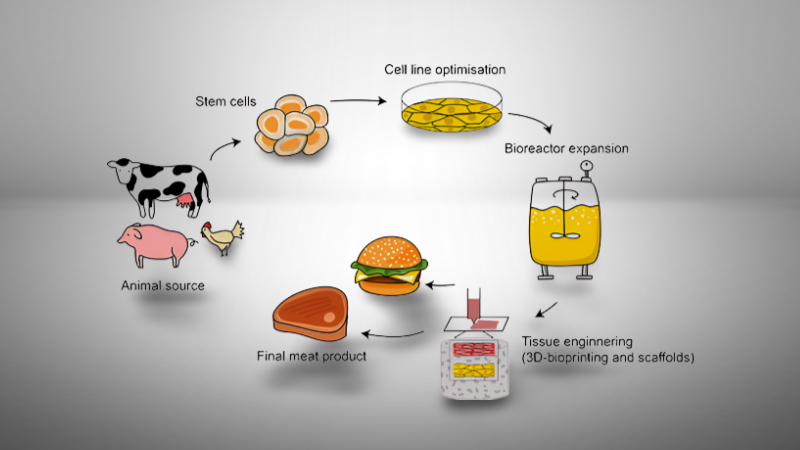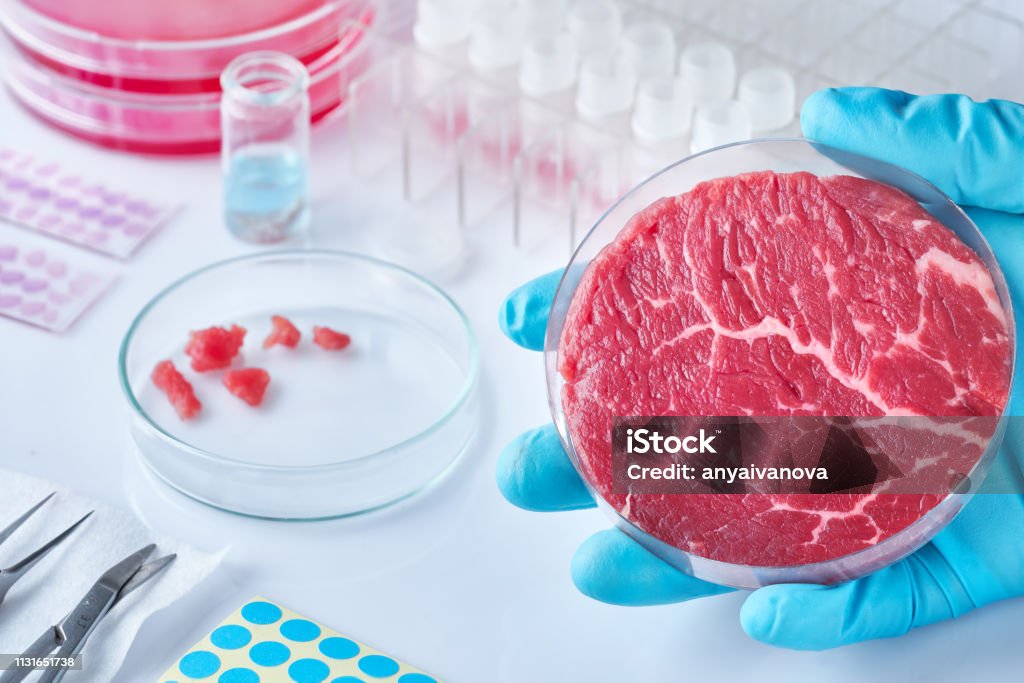Introduction
The world’s population is projected to grow to 9.5 billion by the year 2050. Such a growth in population, in combination with social, economic, and demographic change (urbanization, increasing incomes in emerging markets, etc.) and the associated changes in the pattern of consumption, will put more pressure on various food products linked with various diets. Studies have estimated an increase in meat intake by approximately 60% during 1990-2009, and this trend will likely continue as a result of higher income in countries of Asia, Latin America, and the Middle East. Increased demand for proteins, mainly of animal origin, is expected to have a negative impact on the environment, causing greenhouse gas emissions (GHG), requiring even more water consumption and land exploitation for their production. To counter this urgent issue, an even more sustainable production is needed.
To enable sustainable production and disposal of proteins, there are several potential scenarios both for the exploitation of current sources of protein and also for the discovery and development of new ones, always considering the nutritional, environmental, and technological issues as well as the consumer’s and market reaction. Meat grown in laboratories, while still at an experimental phase, appears to be a future-oriented alternative technology for producing animal-originated proteins and delivering traditionally animal-raised products in a manner that needs much less or no participation from animals whatsoever. This technological innovation also has an ambitious objective to offer the possibility of reducing the negative impact of today’s meat production and consumption on humans, animals, and the environment.
Technology and Cost of Lab-Grown Meat Production

- The method of in vitro muscle tissue culture has existed for over 100 years. In 2013, a group of scientists at the University of Maastricht unveiled the first hamburger made from laboratory-grown meat created from bovine stem cells. This initial burger took over $300,000 to produce, but two years later, the same team was already capable of cutting its cost to $11.36.
- Cell culture meat, or lab-grown meat technology, is part of the new area of cellular agriculture. Meat grown in a laboratory is manufactured by culturing adult muscle stem cells in a collagen matrix derived from live or dead animals and supplying the energy sources needed for their proliferation and differentiation into skeletal muscle tissue strips. Co-culturing fat cells is necessary to impart flavor, texture, and tenderness to the grown meat. The tissue produced can be separated for further processing and packaging. The quantities of essential nutrients and energy are relatively small, as only muscle tissue develops without other biological structures (bones, fat, or skin).
- The production of cultured meat needs proper growth media, ideally of non-animal origin, to avoid animal components containing agents for communicable diseases, and edible materials suitable for cell growth matrices to produce thicker and more continuous meat pieces, such as steaks. Such an effective process for the production of non-animal culture media is still regarded as a great challenge and a very significant step towards the acceptance of cultured meat.
Effect on Public Health
- Lab-grown meat may prove to be a great functional food as it can be engineered to change the profile of essential amino acids and fats, can be supplemented with vitamins, minerals, and bioactive substances so that it not only resembles natural meat but also surpasses it to fulfill special dietary requirements in individuals suffering from different diseases.
- Following the introduction of functional and fortified foods, consumers are willing to relish products that have been altered to contain specific functional and nutritional attributes. Stringently controlled hygiene conditions in sterile systems used for the production of lab-grown meat make a substantial contribution to enhancing its safety by reducing the chances of zoonotic and food-borne pathogens, viruses like avian influenza and swine flu, or prions for transmissible spongiform encephalopathies.
- Scientists also believe that the requirement for pesticides, fungicides, growth factors, and antimicrobials utilized excessively for normal meat production may be greatly lowered as cultured meat consumption rises.
- In the coming years, the continuously rising production and decreasing cost of laboratory-grown meat, perhaps lower than traditional animal husbandry, would render its consumption more affordable and could extend meat access to even developing nations. In this regard, cultured meat has the potential to mitigate some of the nutritional deficiencies among such populations and may aid in the physical and psychological development of children.
Effect on the Environment
- Studies have revealed that replacing traditionally produced meat with cultured meat might result in reduced greenhouse gas (GHGs) emissions because, instead of using land for livestock farming, large areas could be released and redeveloped for purposes such as carbon sequestration.
- It has been observed that if cultured meat is cultivated in the algae culture medium, GHG emissions will drop by 78-96%, land use by 99%, water usage by 82-96%, and energy usage by 7-45% in comparison to conventional farming.
- Production of lab-grown meat could also have potential benefits for the conservation of wildlife by reducing pressure to convert natural habitats to farmland, and also offers an alternative method of generating meat from vulnerable and rare animals that are presently under threat by overhunting as a source of food.
- There would be a considerable reduction in energy consumption for cold transport, as the cultivated meat has a lower mass since there are no inedible components (bones, blood, etc.). Further, slaughter waste and the associated environmental and economic impacts are significantly minimized.
- Tuomisto and de Mattos have revealed that the large-scale substitution of traditional meat production can have certain adverse impacts on rural biodiversity. The potential forestation of the meadows could be advantageous to some species, but others would be at risk. Further research is required to assess the overall environmental impact of cultured meat from the production stage to its final consumption.
Ethical, Socio-Political, and Economic Considerations
- The ethical dilemmas and consumers’ perception are crucial. They are also potential impediments to the success of lab-grown meat. As much as possible, the product should have tactile and organoleptic characteristics (taste, consistency, appearance) similar to natural meat, which is widely accepted by consumers. However, this is difficult to achieve at present. The extent to which muscle biology can be replicated will determine how complicated is the process of culturing meat in laboratories. A more modest and feasible target is the production of a muscle cell comprising only the protein components.
- Stem cell donors pose another complex ethical concern, as these cells must be collected from an animal, and the procedure to obtain the required type of muscle tissue is neither easy nor uncomplicated. Moreover, the necessary serum for growing cell cultures must also be procured from adult or even newborn or fetal sources, raising additional ethical concerns.
- Vegetarians, as well as certain religious groups, do not consider the consumption of meat or other foods of animal origin necessary for human health, and thus, these issues could eventually be an obstacle.
- Another key challenge for the socioeconomic status of this novel technology is the disruption of the livestock industry, where millions of people are directly or indirectly involved. The following questions remain unanswered and need to be addressed by governments and societies:
- What will be the reactions of the stakeholders of this huge and very important field of the global economy?
- To what extent will it replace conventional meat production or increase global meat consumption?
- Will it provide a new frontier for capital accumulation for multinational corporations or a shift towards localized production?
Regulatory framework
The specific legislative and regulatory scheme for lab-grown meat differs from one country to another but typically entails food safety, public health, consumer protection, and animal welfare legislation. Here’s an overview of how some major regions and countries regulate lab-grown meat:
United States
Regulatory Bodies Involved
- FDA (Food and Drug Administration): Responsible for cell harvesting, growth, and differentiation.
- USDA (United States Department of Agriculture): Oversees post-harvest processing, packaging, and labeling.
Framework
- A joint regulatory framework was announced in 2019.
- The FDA performs pre-market safety consultations.
- The USDA inspects facilities and clears labels (supporting truthfulness and non-misleading representations).
Status
- Upside Foods and GOOD Meat were cleared by the FDA and USDA in 2023 to sell cultivated chicken.
European Union
Regulatory Agency
- European Food Safety Authority (EFSA) under the Novel Foods Regulation (Regulation (EU) 2015/2283)
Framework
- Cultivated meat is considered a “novel food”.
- Companies must submit detailed dossiers including production methods, safety assessments, and nutritional data.
- Requires centralized EU approval before market entry.
Status
- No cultivated meat products have been licensed for sale so far in the EU.
Singapore
Regulatory Agency
- Singapore Food Agency (SFA).
Framework
- The first nation to license cultivated meat for sale (2020).
- A safety assessment with production process, media, cell line, etc., needs to be submitted by companies.
Status
- Eat Just’s GOOD Meat cultivated chicken is approved and available for sale at certain locations.
United Kingdom
- Post-Brexit, the UK retained much of the EU’s Novel Foods Regulation, but now applies it independently.
- The Food Standards Agency (FSA) evaluates applications.
Israel
- Emerging regulatory regimes are led by the Ministry of Health.
- Actively encouraging cultivated meat innovation.
China
- No direct regulatory approval yet, but the 5-year agricultural plan identifies cultivated meat as a priority technology area.
Conclusion
Lab-grown meat provides a promising alternative to traditional meat, with adaptable production processes and the ability to address varied nutritional requirements. It is still in its infancy, without large-scale production and with unresolved ethical and social issues. Open stakeholder dialogue is needed to establish public confidence. A sustainable future for food may require a range of solutions like lower meat consumption, eliminating industrial agriculture, encouraging organic farming, and encouraging alternative protein sources, of which cultured meat is a worthy contributor.
References
- (2015) United Nations, Revision of World Population Prospects, United Nations.
- Bhat ZF, Bhat H, Pathak V (2014) Prospects for In Vitro Cultured Meat-A Future Harvest: Principles of Tissue Engineering, (4th edn.). Elsevier.
- Bhat ZF, Kumar S, Fayaz H (2015). In vitro meat production: challenges and benefits over conventional meat production. Journal of Integrative Agriculture 14(2): 241-248.
- Henchion M, Hayes M, Mullen AM, Fenelon M, Tiwari B (2017) Future protein supply and demand: Strategies and factors influencing a sustainable equilibrium. Foods 6(7): 53.
- Henchion M, McCarthy M, Resconi V, Troy D (2014) Meat consumption: Trends and quality matters. Meat Science 98(3): 561-568.
- Mattick CS, Landis AE, Allenby BR (2015) A case for systemic environmental analysis of cultured meat. Journal of Integrative Agriculture 14(2): 249-254.
- Moritz MSM, Verbruggen SEL, Post MJ (2015) Alternatives for large-scale production of cultured beef: a review. Journal of Integrative Agriculture 14(2): 208-216.
- Tuomisto HL, Teixeira De Mattos, MJ (2011) Environmental impacts of cultured meat production. Environmental Science and Technology 45(14): 6117-6123.
- Westhoek H, Rood T, Van Den Berg M, Jansej Nijdam D, Reudink M, et al. (2011) Food and Agricultural Organization of the united states.
- Woll S, Bohm I (2018) In-vitro-meat: a solution for problems of meat production and consumption? Ernahrungs Umschau 65(1): 12-21.




